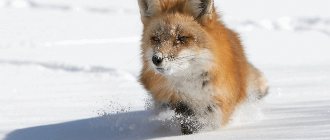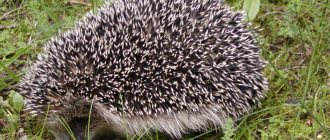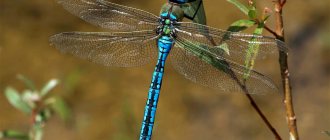| Class : Mammals | Family : Canidae | Order : Carnivores |
| Subfamily : Wolf | Genus : Foxes | |
The red fox is the personification of cunning and resourcefulness, the heroine of fairy tales and legends, a beautiful fur-bearing animal that lives almost everywhere.
Natural cunning and caution help her survive in the most unfavorable conditions. The animal lives in almost all climatic zones: forests, steppes, mountains, deserts. They can be found in the icy Arctic, in the mountains of Tibet, and in the sultry Sahara. This article will help you find out what the fox eats, where it lives, how it hunts and reproduces. Information from authoritative sources will be useful to the child when preparing a report, writing an essay, or a scientific project.
Foxes: who they are and from whom they came
The domestic name of the animal has Old Slavic roots.
In ancient times, the adjective “fox” was in use, meaning a yellowish, red color. Others see parallels with the word “dashing,” emphasizing the hunting qualities of a predatory animal. The distant ancestors of modern foxes were discovered in North America, where they lived about 50 million years ago. The fossil remains belonged to animals with a long body and short legs. Foxes came to Europe and Asia later - during the Pleistocene period.
Sounds a fox makes:
Mammal or not
Many people wonder: does a fox belong to the cat or dog family?
Zoology classifies animals as carnivorous mammals, the canine family. They are united by communication with distant relatives using barking sounds and some habits in the wild.
It’s curious, but you can find many similarities in foxes with cats. Hunting tactics, excellent vision, predominantly nocturnal animals, weakness to small rodents. Here we also add protruding sharp claws and a rough tongue.
Omnivore or carnivore
The fox is a typical predator, but in nature it feeds on a wide variety of foods. Potential prey could include about 400 species of small animals, insects, and dozens of plant varieties.
Favorite food: small rodents. In cold winter, mice are often the only source of food. The predator catches the rustles and squeaks of rodents under deep snow, after which with a quick movement it dives under the snow and grabs the prey. This method of hunting even received its own name - mouseing.
Birds, hares, and large game are rarer prey, which the animal hunts occasionally.
Is the fox listed in the Red Book?
Foxes are so widespread around the world that it is impossible to answer this question unequivocally. The furry animals manage to maintain a stable population throughout their distribution area. In many ways, relative omnivorousness and natural caution help the animals.
Other species are less fortunate. Due to their beautiful skins and the steady decline of their ancestral habitats in some areas, the American corsac fox, American fox, Bengal fox, and Tibetan fox are under threat of extinction.
Animals lead the most hidden way of life, so estimating their numbers is fraught with great difficulties and is always approximate.
How to hunt a fox
The fox is a cunning animal, so the methods of hunting it are very diverse:
- with hound dogs,
- with semolina,
- surge,
- from the approach
- on the bait,
- with burrowing dogs, as well as
- salary hunting with flags.
Photo 2. Hunting a fox is not an easy task.
Each type of fox hunting requires special knowledge and skills from the hunter.
When catching a fox from a smoothbore gun, it is preferable to use charges filled with shot No. 1 - No. 2.
Where do foxes live
In the course of evolution, foxes have successfully mastered almost all climatic zones. Fluffy animals can be found in permafrost and sultry deserts, in steppes and mountainous regions. Animals do not favor the dense taiga; they prefer sparse, spacious forest areas.
Burrows are used as shelter. Some species dig holes themselves, others occupy the abandoned homes of other animals, adapting them to their size.
The proximity of human settlements does not bother the animals. They happily settle nearby, regularly visiting in search of food. There have been cases where foxes lived in large city parks.
Fox diet
What does a fox eat? The fox is a predator. Its menu consists of various small animals - voles, gophers, hares, partridges, ducks. Consumes foxes and carrion. It can also eat scraps left from larger animals - bears, wolves.
Foxes living in the steppes can hunt for a variety of large beetles, locusts, termites, and frogs. If there is a river nearby, the animals will not hesitate to go fishing - they love fish. In summer, fruits, berries, and fruits are added to the diet.
What does a fox eat in the wild?
Foxes are skilled hunters and natural predators. Their main meat dish is mice, gophers, hamsters, and other small rodents. The fox will not refuse hare meat either, but catching a nimble animal is much more difficult.
Predation of bird nests is another weakness of furry predators. Here eggs, unfledged chicks, and adult birds are used. Foxes also do not neglect plant food. They will enjoy juicy berries, fruits, and herbs with pleasure.
Folklore undeservedly attributes to foxes the glory of thunderstorming rural chicken coops. Animals can only be driven to undertake such a dangerous undertaking by severe hunger, when it is impossible to find food in the forest.
Steppe breeds often catch snakes, turtles, lizards, and frogs for lunch. In harsh mountainous areas it is more difficult to find food. Here, in search of food, animals have to run along steep cliffs and sit in ambush for hours. If birds, rodents or reptiles cannot be found, the predatory animal will be content with carrion.
Advantages and disadvantages
Do not forget that the fox is a predator, and, succumbing to instincts, it can bite its owner
Whatever fox you choose - a descendant of a red or silver fox, a baby fennec fox - you should remember that this animal requires special conditions of maintenance and care, as well as a trained owner. A domestic fox is not a dog. She will not run to your leg at the first call and it is useless to expect dog loyalty from her. And you can’t compare her with a cat either. The genes of a wild predator and an unpredictable temperament make living with a domestic fox a rather risky proposition, especially for families with small children.
Advantages and disadvantages of a fox as a pet:
- Not every country allows you to keep a fox at home.
- The smell of fox is strong and unpleasant.
- The animal is a loner by nature, independent and on its own mind. It is difficult to predict the course of his thoughts, as well as to control his behavior.
- The fox is a burrow inhabitant. You need to be prepared for the fact that she will dig in the house - on the sofa, under the sofa and in other places
- Active and inquisitive. Will vigorously develop the territory. You always need to be on your guard, otherwise you won’t be able to avoid chewed up pants and puddles on the carpets.
- Even the female marks her territory.
- Poor toilet training.
- Screams at night.
- Bites.
- Jumps high, especially the fennec.
- Domestic hamsters, mice, rabbits and chinchillas are prey for foxes, not friends.
- Active and inquisitive. You won't get bored with her.
How many years does a fox live?
The lifespan of an animal is largely determined by its habitat.
In the forest
Life in the wild is not easy for foxes. Numerous enemies, climatic conditions, dangerous diseases - all these factors do not contribute to an increase in life expectancy. It will be great luck for a predator to live to at least 6 years. The average lifespan of an animal is about 2-5 years.
Infectious diseases, to which foxes are extremely susceptible, have a huge impact on the population size. Epidemics of the following deadly diseases regularly break out among animals:
- encephalitis;
- rabies;
- plague.
If plague and encephalitis are not transmitted to humans, then you should be extremely careful with a rabid fox. It is prohibited to remove skins from such animals; it is best to burn the carcasses. A person bitten by a sick animal should urgently seek medical help.
Often, after an outbreak of infectious diseases, the number of foxes in a certain area is reduced by 5-10 times. Over time, the animal population recovers.
At home
When discussing how long foxes live at home or in zoos, it is worth considering that negative factors here are minimized. A veterinarian will take care of the animal’s health, a caring owner will take care of food, and there are no hostile predators nearby. Here the fox has an excellent chance of living to 20 years or more.
Reproduction and offspring
The period for the birth of puppies (as fox cubs are called) is mainly considered to be mid-spring. To breed, foxes dig a deep hole, but sometimes they can occupy someone else’s. Typically, one female gives birth to four to six cubs. Pregnancy lasts from 44 to 58 days. After birth, the mother feeds the offspring with milk for about 1.5 months. When the cubs turn 2 years old, they become fully grown individuals. Mature fox cubs are fed with live prey, and the fox cubs kill the “food” themselves.
Lisa is a good mom. Almost always all the fox cubs survive, of which there can be up to 6-7
Types of foxes
Foxes have learned to adapt perfectly to environmental conditions. Cunning and ingenuity help predators feel quite confident on almost all continents. The animals ignored only the uncomfortable Antarctica. Zoologists have still not come to a common point of view, but according to most scientists today, 11 species of furry animals belong to the genus of foxes.
sand fox
The species is distributed in northern Africa, covering the territory of Morocco, Egypt, Somalia, and Tunisia. To the east, the fox is found on the Arabian Peninsula, reaching Pakistan, Israel, and Jordan.
The animal has a slender body 40-50 cm long, reaches a height of 30 cm. The weight of an adult is 1.5-3.5 kg. The fur is dense and soft, predominantly light brown in color. There are dark spots near the eyes, and a white mark on the tip of the tail. Like many desert inhabitants, the animal's paw pads are pubescent.
They live in underground burrows in large family groups and are nocturnal. Sand foxes are practically omnivores. They will be satisfied with reptiles, eggs, fruits, plant tubers, beetles, rodents, and any food waste.
Animals do not need open sources of water; the required amount of moisture is obtained from food.
Attitudes towards the animal population in different countries are fundamentally different. Thus, in Israel, sand foxes are protected by the state; in Morocco, on the contrary, they have the status of pests.
Bengal fox
An animal of medium size, reaching a height of 26-28 cm and weighing 1.8-3.2 kg. The body length of the predator is 45-60 cm. The color of the short six varies from orange to reddish-brown shades. The fluffy tail is decorated with a black tip.
It lives in the mountainous regions of India, Nepal, and Bangladesh, preferring open fields and sparse forests. Monogamous pairs of animals settle in burrows. For a short rest, they dig simple dens with two exits; for raising offspring, they dig complex structures with rooms, corridors, and numerous exits.
They feed on reptiles, insects, small mammals, and birds. The number of the Bengal variety is quite high, but tends to decline due to a reduction in its natural habitat. On average, one individual accounts for about 10-50 square kilometers of territory.
Steppe fox or corsac fox
Corsacs can be found in China, India, Kazakhstan, Pakistan, Mongolia, Uzbekistan, Turkmenistan, and a number of other countries. In Russia, this species is represented in Western Siberia and the North Caucasus.
The corsac differs from the common fox in its smaller size. The body length of the predatory animal is 50-60 cm, height is 30-35 cm, weight is about 5 kg. The ears are large, pointed, the muzzle is short, the legs are long. Color varies from gray to tan and red. The belly is lighter, the tip of the tail is black, less often dark brown.
The length of an animal's fur is subject to seasonal morphism. The winter coat is fluffy and long, the summer coat is short and sleek.
They live in burrows, preferring to occupy the ready-made homes of marmots, badgers, and their relatives. Corsacs hunt mostly alone, waiting until dusk. The diet is based on voles, marmots, jerboas, and hares.
Animals can go for a long time without water, receiving it from food. In a hungry year, the beast does not disdain carrion and garbage.
The species competes with the common fox.
There is no exact data on the population size, but the species is listed in the International Red Book.
fennec
The smallest member of the canine family lives in the desert and semi-desert regions of Africa. Translated from Arabic, “fenech” means “fox”. The body length of an adult does not exceed 80 cm, half of which is the animal’s fluffy tail.
One can only envy the endurance of fennecs. Animals are able to go without water for a long time, and the thick fur on their paw pads helps them move on hot sand. The huge erect ears of the animal play an important role. They not only catch any rustle, but also perfectly cool the body, removing excess heat through a network of thin capillaries.
Fenechs live in large family groups, digging deep holes with an intricate labyrinth of rooms and passages.
Tibetan
The animal lives in the steppe and semi-desert regions of Tibet, Nepal, and in several regions of India and China. The basis of the diet of the Tibetan variety is the small rodents pika. It leads a very hidden lifestyle; for the first time it was possible to film the beast on video only in 2006.
It differs from its relatives in its powerful jaws with long fangs and a strange, almost square head shape. The eyes of the predator are narrowed and located high. Thanks to its thick fur, the animal seems very massive, although the weight of an adult does not exceed 5-6 kg.
Like most Tibetans, he has a peaceful and calm appearance.
Marble
One of the subspecies of red foxes with luxurious fur. This coloration does not occur in the wild. The marbled (sometimes Canadian marbled) fox was bred artificially for its beautiful fur.
White fox
Arctic foxes, which are often called white foxes, are not white foxes in the strict sense. The polar animal is classified in its genus Alopex, considered an intermediate link between wolves and foxes. Some scientists, however, classify the animals as a glorious family of foxes.
Arctic foxes grow up to 50-70 cm in length and up to 30 cm in height. The average weight of the animal is 3-4 kg. In winter, the fur of the Arctic fox turns into a fluffy snow-white coat, very warm, almost invisible in the snow and, unfortunately, considered a valuable commercial resource. In summer, the animal's fur becomes shorter and acquires a dirty brown tint.
Excellent hearing and sense of smell make animals excellent hunters. Arctic foxes deftly extract lemmings, mice, and other rodents from under the snow. The harsh climate leaves its mark on the lifespan of the animals - on average they live 3-4 years.
Genus Urocyon (Grey foxes)
Gray foxes are very beautiful animals. They live in different states of America. Most often, the weight of a gray fox reaches 5 kg, and its body length is more than half a meter. The fur of this type of fox is not completely gray: only the upper part of the body and tail are silver. Gray foxes are considered similar to raccoons. But, unlike the latter, foxes have short red hair on their paws. Moreover, the fur of gray animals is not as lush as that of other relatives. There is also a black comb of coarse wool running along the tail.
The gray fox is considered one of the most dexterous animals: it has good hearing and vision, runs fast and is even able to climb trees, for which it received its nickname “arboreal”. A male and female gray fox form a monogamous pair and if one of them dies, the other partner does not form a new pair.
The most common species of gray fox is the Island fox, which lives in California. It differs from other gray faces in that it has a “modest” size and feeds mainly on insects.
Enemies: who eats foxes in nature
Cunning and cautious animals have plenty of ill-wishers:
- the Bears;
- wolves;
- wolverines;
- large predatory cats;
- dogs;
- badgers;
- feathered predators.
Weak cubs are often attacked by hawks, crows, and eagle owls.
The main enemy of foxes is man. People traditionally hunt these animals for their luxurious fur, sometimes just for sport.
An adult fox is by no means an easy prey. The animal runs fast, swims well, masterfully confuses its tracks, and hides well. If necessary, a predatory animal will pretend to be dead and climb a tree.
Genus Otocyon (Big-eared foxes)
Big-eared fox breeds (otocyon megalotis) live in Africa. Moreover, there are 2 populations that live near Zambia, Ethiopia and Tanzania. Foxes live in open areas, preferring to hunt insects, which make up 80% of their diet. The body length of the animal with huge ears reaches 60 cm, the tail length is about 35 cm, and the weight is more than 4 kg. The color can be gray or light red, and on the paws, muzzle and around the eyes there are transitions of gray to black fur. A fox has a black stripe of fur on its back.
The most important difference between this breed of fox and other species is the presence of large ears. Their length can reach 12 cm. Big-eared foxes are also distinguished by their special teeth structure: they have additional molars. Thus, the total number of teeth they have can reach 50 units. This allows the fox to eat insects even with a hard shell.
Mention in art
The fox is a character in all kinds of children's fairy tales and stories, thanks to its unusually bright appearance, bushy tail and beautiful fur. In the mythology of different countries, it appears as several symbols: from a sacred animal to a werewolf turning into a human.
Very beautiful in pictures and cunning in children's books, the fox evokes a negative reaction, but this attitude towards the animal is stereotypical, while in reality it does not intentionally seek to harm humans, living mostly in the wild. In fairy tales for children he plays the main role along with the wolf and the bear.
Genus Dusicyon (South American foxes)
This species of fox lives only in South America. They are distinguished by their gray color with small red patches, densely packed fur, relatively small ears and a sharp muzzle. The following species belong to the genus of South American foxes:
- Andean. This fox with a silver head and body and reddish-brown paws and ears inhabits the highlands of the Andes, Ecuador and Peru. Its weight can reach 11 kg, and its body length is usually more than a meter.
- South American. This species of fox, which has a more variegated color, lives mainly in Argentina and Chile. Moreover, predatory animals prefer to be located on more level terrain. Their body length is about 67 cm and their weight is about 4.5 kg. Animals move very quickly and can also create burrows with several passages underground.
- Paraguayan. This species of fox also inhabits the territory of Chile, Argentina, and Paraguay. The fox is of medium length and weight, has gray fur with white patches on the back and tail, and yellow paws.
- Sekuranskaya. This species of fox is found in the deserts of Ecuador and Peru, which is distinguished by a grayish coat color, a black tip of the tail and black tips of the paws. The body length can reach 60 centimeters, the tail length is almost half the body length, and the weight is 4.5 kg.
- Brazilian. True to their name, these animals inhabit the south and center of Brazil. These chanterelles also cannot be called large, since their maximum weight can only reach 4 kg. The body length is 60 centimeters. The fox has a small, short muzzle, gray fur on its back and white spots on its belly. There is also a black stripe running along the upper back and tail.
- Darvinova. This fox species is endangered. It received its name in honor of the famous biologist Darwin, who wrote that a special species of fox, currently unknown, lives on the island of Chiloe.
This unique species of South American fox has a dark brown color and red fur on its head. The main difference between the Darwinian fox and other species lies in the length of its paws: they are somewhat shorter. The fox found today in the Nahuelbuta National Park and in Chile can weigh only about 2 kg, and its body length can be more than 50 cm.
- Maikong. The fox with such an unusual name lives mainly in the forests and savannas of Argentina, Colombia, Paraguay, and Venezuela. It is distinguished by gray fur with brown patches. Its muzzle is not as pointed as other fox species, and its paw pads are larger. The average body length is 65 cm, the tail length is 30 cm, and the weight is from 5 to 8 kg. Maikong not only hunts rodents or insects, but can also feast on plants and fruits (bananas, mangoes). The animal, which resembles a dog, does not like to arrange its own home and occupies other people’s holes.
- Short-eared. This fox also lives in the forest and is widespread in Ecuador and Peru, Brazil and Venezuela. The short-eared fox prefers to live along rivers and hunt there. Animals of this species are considered quite large: their body length can be more than a meter and their weight can reach 9 kg. They also have strong and long teeth. In order to get food and remain invisible to potential prey, the fox has a dark color and moves like cats. And, despite the small size of her ears, she has fairly good hearing.
The number of owners of a fluffy tail
The number of foxes varies depending on the year. Their reproduction is affected by both various diseases and their absence. In addition, meteorological conditions, the number of rodents, infectious diseases.
In the absence of the required amount of prey, many puppies can die from starvation, and the fertility of females also decreases. In addition, during the famine period, favorable conditions arise for the spread of diseases such as rabies, scabies, and plague. Infections often cover large areas.
Fox species have a huge number of subspecies - more than 40, second only to wolves. These include:
- Fennec.
- Gray fox.
- Tibetan.
- Ordinary.
- Corsac.
- Big-eared.
- Paraguayan.
- Maikong.
- Sandy.
- Ostrovnaya.
- Brazilian.
- Bengal.
- South African.
- Small.
- Falkland.
- Darwinovskaya.
- Sekuranskaya.
The silver fox is used in livestock production for fur. Its fur can be either completely black, only the tip of the tail is white, or gray with a bluish or brown tint. But there are ashy ones on the sides.











